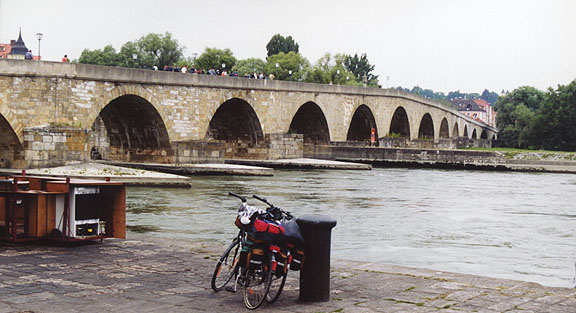

Regensburg

Steinerne
Brücke
(1135 - 1146)
Regensburg, city in southeastern Germany, in Bavaria, a port at the confluence of the Danube and Regen rivers. Along with its shipyards, the city's industries manufacture processed food, machines, leather goods, chemicals, and printed materials.
on the Danube
Salt House in backgroundRegensburg is considered one of the best-preserved medieval cities in Germany.
in the old city
building detail
the windows
Among the many historical buildings here are Saint Peter's Cathedral (begun 13th century), the former city hall (14th-18th century), Saint James's Church (early 12th century), and Saint Emmeram's Church (5th century).
the locksmith's shop
Its abbey of the Benedictines became an important center of European learning, and the abbey's library contains more than 200,000 books and illuminated manuscripts. Saint Peter's Cathedral has maintained a well-known boys' choir for more than 1000 years, and has a museum of medieval and Renaissance church art.
the cathedral spire
passage from the Bishop's residence to the cathedral
The city's Stone Bridge across the Danube (completed 1146) was the only Danube crossing for hundreds of years, and was the starting point of the second and third Crusades. The city is the seat of a university.
the square
different style window treatment
Around 500BC Regensburg was a settlement of the Celts. The Romans later utilized the community as a fortress city from the 2nd century to the 5th century.
Porta Praetoria
Northern gate of the Roman Fort
Regensburg became a free imperial city in 1245. From 1663 to 1806 it was the permanent seat of the diet of the Holy Roman Empire and one of its most important commercial and political centers. Saint Albertus Magnus taught in Regensburg from 1236 to 1240 and was its bishop from 1260 to 1262.
Bischofshof
the restaurant
The painter and architect Albrecht Altdorfer spent most of his life in Regensburg. In 1810 the city became a Bavarian possession. Population (1990 estimate) 120,900.
Text from Microsoft Encarta
![]()
![]()